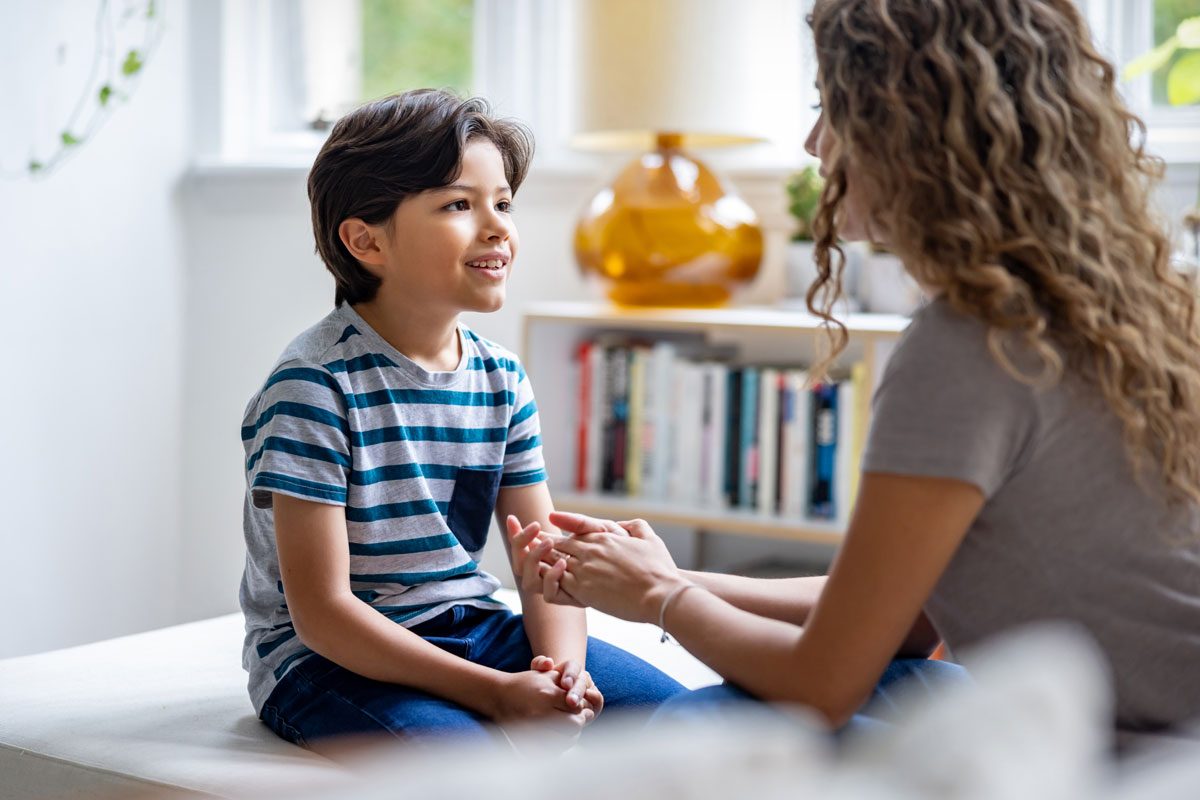You may get more attention and have higher academic achievement, but there is a major downside to being born first

Are You the Firstborn in Your Family? Here’s How It Affects Your Entire Life, According to a New Study

Think of the classic stereotypes about firstborn children: the responsible perfectionist, the overachiever, the sibling caretaker and the enforcer of rules … basically the mini adult in the household. Cool, now you’ve met me. (Oh, hi! Pleasure is all mine! Please sit down! Can I get you a glass of water? A heated blanket? A codependent relationship?)
It’s true: I’m the oldest of six kids, and I check all of the firstborn boxes. Heck, the fact that I listed out the criteria hints at my oldest-child, type-A personality! But while these stereotypes are often the punch lines to lighthearted family jokes, a new study suggests there may be more to them than we realized—and they can affect our whole lives.
Fellow oldest children, let’s examine the study together and find out the surprising connection the researchers found between birth order and a common issue that may be impacting you right this minute. Later-born kids, you’re welcome to read along—after you’ve taken your bath, finished your homework and apologized for not listening to all of our unsolicited advice. (I’m kidding! Please don’t send me angry emails … or run to Mom and Dad.)
To help us find answers, I interviewed Kersten Bartelt, RN, one of the principal researchers of the study. Read on to discover what the study reveals and how the findings could affect families, plus get Bartelt’s tips for improving your life—and your parenting.
Get Reader’s Digest’s Read Up newsletter for more news, humor, travel, tech and fun facts all week long.
How were firstborn children evaluated in this study?
Bartelt and three other scientists from Epic Research conducted an in-depth analysis of more than 182,000 children born between 2009 and 2016. Their goal? To investigate the connection between birth order and mental health, specifically the likelihood of anxiety and depression diagnoses by age 8.
The study accounted for multiple variables that could affect mental health, including the child’s sex, age, race/ethnicity, family medical history (including maternal anxiety or depression), premature birth status and birth weight. It also took into account socioeconomic factors, such as insurance coverage and the type of neighborhood the kids lived in.
By controlling for these factors, the researchers were able to isolate birth order as a significant player in mental health outcomes. What they found was pretty surprising.
What did the study reveal about firstborn children?

Oldest children are at greater risk for certain mental health conditions, according to the study. That was surprising to me, as I’d never thought about the impact my eldest-child status has on my mental health.
Bartelt was less shocked. “I wouldn’t say we were surprised by what we found,” she told me. “But I would say the findings were insightful and highlighted an area that has not yet been researched within childhood mental health.” So what, exactly, did they learn?
-
Firstborn children with siblings were 48% more likely to be diagnosed with anxiety and 35% more likely to experience depression compared with their later-born siblings.
-
Only children were also at increased risk, showing a 42% higher likelihood of anxiety and 38% higher likelihood of depression than children with siblings.
This data shows a clear trend: Being the oldest or only child increases your risk of depression and anxiety. As someone who has been diagnosed with an anxiety disorder and is currently taking an antidepressant medication, well, this explains a lot.
When do these cognitive changes start?
This brings up the age-old debate of nature versus nurture: Are oldest kids simply born this way, or does this tendency toward depression and anxiety start once our younger siblings are born? (There’s a sad sentence if I’ve ever had to write one!)
“We were unable to untangle the complexities of nature versus nurture for this study,” Bartelt says. “Further research would be needed to investigate when the onset of these changes occur.”
But while this study didn’t look into prenatal influences, previous research suggests some of these changes may start in the womb. For instance, a 2024 study published in Psychoneuroendocrinology found that babies who were born to mothers experiencing high levels of stress during their pregnancies were more likely to have high levels of inflammation in their brains, which may explain the higher incidences of depression and anxiety as they got older.
Over time, this vulnerability may be compounded by the family dynamic. Firstborn children often absorb more pressure and responsibility from their parents, leading to heightened stress and emotional strain as they grow older. The role of parental expectations, academic pressure and leadership responsibilities within the family may exacerbate these tendencies.
Does this mean we’re doomed to be depressed and anxious throughout adulthood? Not necessarily, Bartelt says, adding that we don’t have enough information. However, people who experienced mental health issues as adults were more likely to have had anxiety or depression as children or teens, according to the National Institute of Aging. So there may be an ongoing risk, even into our elder years.
Is there a difference between oldest girls and oldest boys?
There is a difference, but it’s a small one. “We adjusted for the child’s sex, and after the other adjustments in our model, we found that female patients did not have a statistically significant difference in the likelihood of anxiety, though they were less likely to be diagnosed with depression,” Bartelt says.
Boys and girls often experience different societal and familial expectations related to their gender, which can shape their mental health. But it appears that the risk to their mental health is about the same.
What should parents do with this information?

Awareness is the first step. Understanding that firstborn and only children may be at a higher risk for anxiety and depression allows you to adopt preventative measures early on.
“Parents can use this information to be more aware,” Bartelt says. She recommends four strategies for parenting firstborn and only children:
-
Maintain open communication. Check in regularly with your child about how they are feeling.
-
Keep regular medical appointments and screenings. Pediatricians are trained to look for anxiety and depression, even in young children.
-
Teach healthy coping mechanisms. Things like meditation, exercise and mindfulness work great for children and adults.
-
Reduce pressure. Consciously avoid putting extra expectations on your oldest child.
“Doing these things won’t eliminate the risk, but it can help mitigate the risk of anxiety and depression for your children,” she says.
How does birth order affect other children?
In 1964, psychologist Alfred Adler developed a theory about how birth order shapes personality development. People quickly latched on to it, likely because it resonated with their personal feelings and experiences, but subsequent research has been mixed.
Smaller studies have noted correlations between birth order and personality, but a 2015 paper published in the journal PNAS contradicts the findings. The study of more than 20,000 people in Great Britain, the United States and Germany found that birth order “does not have lasting effect on broad personality traits” such as extroversion, emotional stability or agreeableness.
But that doesn’t mean there’s no truth to Adler’s theory. Other studies have linked personality and birth order. Read on to find out how that might play out for middle and youngest children.
Middle children
Case in point: “Jan syndrome,” named after the middle child from The Brady Bunch. The stereotype is familiar—the overlooked middle child, struggling to carve out a unique identity apart from their older siblings—but it’s not entirely wrong.
While the research doesn’t support the existence of “middle child syndrome,” it does find some unique challenges for the sandwiched siblings. For instance, a 2018 study found middles were less comfortable talking with their parents about important topics, a 2016 study found that they have high levels of toxic perfectionism and a 2014 paper concluded they are more likely to engage in delinquent or criminal behavior.
Youngest children
Similarly, later-born children often benefit from the more relaxed parenting styles that develop as parents grow more experienced and have more resources. These kids are often seen as more carefree than their older siblings.
Get this: Youngest siblings were more likely to be able to whistle, do a cartwheel and own a dog, according to a survey done by genetic testing company 23andMe. Later-born kids, and youngest children specifically, may benefit from parents’ bigger bank accounts after older siblings have flown the nest, leaving more time and money for the last baby bird. The research on this is mixed, but I present to you the fact that my baby sister got a car for her 16th birthday. Not only did I not get a car for my 16th, but I had to pay my own driver’s license fees. Not that I’m still bitter about that.
But younger kids are not without their challenges, such as living in the shadow of their older siblings’ accomplishments. Younger children are also more likely to be rebellious and take risks, according to a 2010 study.
The bottom line
Firstborn children, take note: If any of this info is causing you anxiety, know that birth order isn’t destiny. This latest study sheds light on the subtle ways it may shape mental health outcomes, but by understanding the ways your birth order affects you (and your children if you have them), you can be proactive about taking care of mental illness early on. All children deserve to thrive, no matter their place in the sibling lineup.
And if my parents are reading this … it’s not too late to buy me a car. Just saying.
About the expert
|
Why trust us
At Reader’s Digest, we’re committed to producing high-quality content by writers with expertise and experience in their field in consultation with relevant, qualified experts. We rely on reputable primary sources, including government and professional organizations and academic institutions as well as our writers’ personal experiences where appropriate. We verify all facts and data, back them with credible sourcing and revisit them over time to ensure they remain accurate and up to date. Read more about our team, our contributors and our editorial policies.
Sources:
- Kersten Bartelt, RN, research clinician and co-author of the study; email interview, Jan. 2. 2025
- Epic Research: “Firstborn Children and Only Children More Likely to Have Anxiety and Depression Than Later-Born Children”
- Psychoneuroendocrinology: “Associations between prenatal stress with offspring inflammation, depression and anxiety”
- National Institute of Aging: “Depression and Older Adults”
- The Journal of Individual Psychology: “The Relationship of Birth Order and Gender with Academic Standing and Substance Use Among Youth in Latin America”
- PNAS: “Examining the effects of birth order on personality”
- Sex Education: “Birth order and parental and sibling involvement in sex education. A nationally representative analysis”
- Indian Journal of Psychological Medicine: “Does Birth Order and Academic Proficiency Influence Perfectionistic Self-presentation Among Undergraduate Engineering Students? A Descriptive Analysis”
- Personality and Social Psychology Bulletin: “Ordered Delinquency: The ‘Effects’ of Birth Order on Delinquency”
- 23andMe: “Quiz Answers: Oldest vs. Youngest — Success, Personality, and Health”
- 23andMe: “Sibling Rivalry”
- Personality and Social Psychology Review: “Birth Order and Risk Taking in Athletics: A Meta-Analysis and Study of Major League Baseball”























